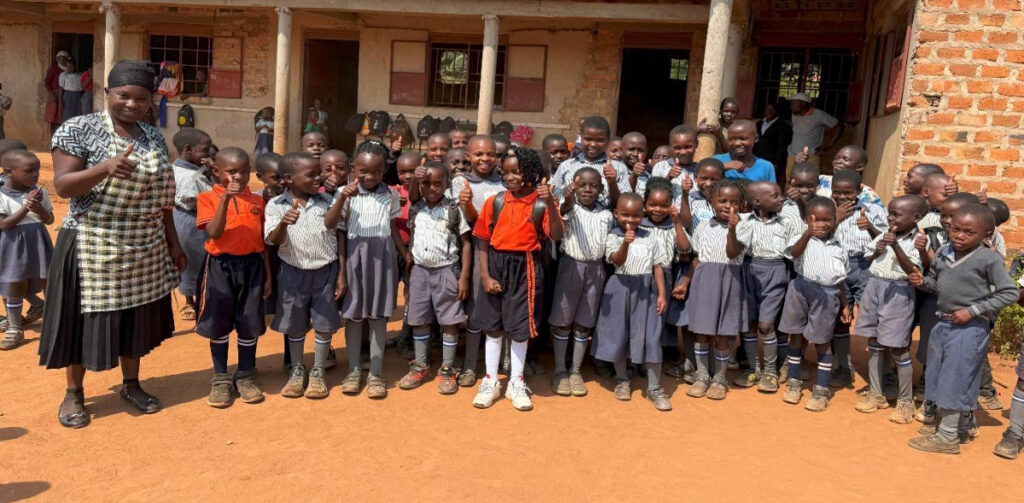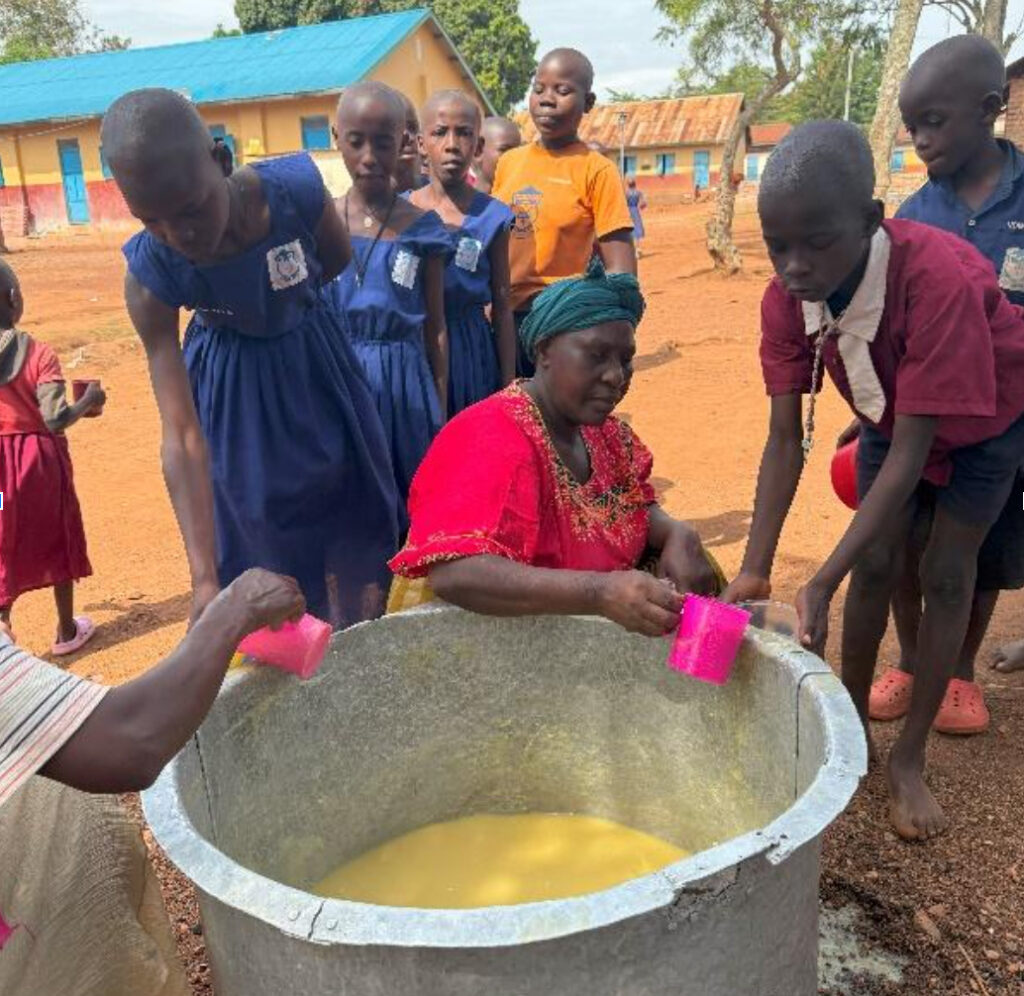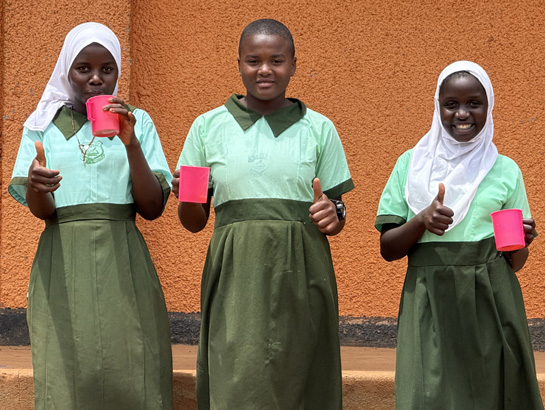One key outcome of the Government of Canada-funded Expanding Nutrients in Food Systems (ENFS) project is the integration of biofortified crops into distribution and feeding programs across its implementation areas. In Uganda, the ENFS project has actively advocated for the inclusion of biofortified crops in school meals and food security initiatives led by local governments and non-governmental organizations (NGOs), particularly those addressing malnutrition in women and children. This initiative has seen significant success in schools, with many either cultivating biofortified crops in their school gardens—storing the harvest for school meals—or intentionally purchasing nutrient-enriched foods for school feeding. In both cases, HarvestPlus has played a crucial role in linking schools to quality seed sources or connecting them with producer groups supplying biofortified foods.
Through advocacy and collaborative partnerships, HarvestPlus Uganda is contributing to transforming food systems and ensuring that school meal programs provide nutritious meals for learners. The introduction of vitamin A maize, iron beans, and vitamin A orange sweet potatoes into school feeding programs has significantly improved access to nutritious foods and academic engagement. Schools have reported increased enrollment and improved overall well-being among students. While challenges such as theft, inadequate storage, and pest vulnerability persist, the initiative holds great promise for long-term integration and expansion. Additionally, schools provide a stable market for farmers, enabling parents to keep their children in school, particularly in cases where schools allow families to use their produce to offset tuition fees.
Baseline Situation
As of 2020, only 30 percent of schools in Uganda provided at least one meal a day (NPA, 2020). Even in those that did, the meal often consisted of plain maize porridge—neither appealing nor nutritious. Hungry learners struggled with low energy levels, poor concentration, and suboptimal academic performance. With the introduction of nutrient-dense foods in school meals, student enrollment has increased, and previously hungry learners now report higher energy levels, improved concentration, and better academic performance. For example, at St. Kizito Ssenyomo Primary School in Butambala district, low enrollment was a persistent issue, with many students leaving school at lunchtime in search of food—often not returning for afternoon lessons.
Project Implementation
When vitamin A maize (VAM), orange sweet potatoes (OSP), and iron beans were introduced in Luwero in 2024, HarvestPlus actively promoted these biofortified crops in several schools. The director of Light Start Junior Academy in Luwero was among the early adopters, purchasing VAM flour and iron beans to trial at the school. The children enjoyed the enriched food so much that she decided to cultivate the crops herself in 2024.

“The children are drawn to the bright color of the maize and sweet potatoes. The maize is naturally sweet and doesn’t require extra sugar when prepared as porridge for the mid-morning break,” said Namubiru Janet, director of Light Start Junior School. She further noted, “Before we introduced these foods, we relied on three Elf trucks (light duty Isuzu commercial trucks commonly used for delivery)—of firewood for cooking. Now, we only need two, allowing us to allocate the savings to other school expenses.” This also highlights that biofortified crops cook faster, reducing fuel consumption.
At St. Kizito Ssenyomo Primary School, a collaboration between Knowledge for Children and HarvestPlus led to the procurement of 20 kilograms of vitamin A maize seed. Learners actively participated in planting, weeding, and harvesting. “Today, VAM is being served in the school, and since the introduction of the afternoon meal of orange maize porridge, student enrollment has increased from 281 in 2024 to over 400 in 2025,” said Kibuuka Akaya, the school’s deputy headteacher.
Similarly, through a partnership with The Hunger Project, 12 schools introduced VAM and iron beans into their school gardens and are now serving VAM porridge to students—reporting similar positive outcomes.
At Bupadhengo Boarding Primary School in Kamuli District, deputy headteacher Jonathan Akola has observed significant improvements in student academic performance following the introduction of VAM and OSP. The school, which has 1,647 learners (836 boys and 811 girls), now serves vitamin A maize porridge twice a day, orange sweet potatoes twice a week and iron beans daily.
“The students now maintain a healthier weight, and their skin appears smoother and brighter,” Akola noted.

HarvestPlus plays a crucial role in facilitating the integration of biofortified crops into school feeding programs by connecting schools with quality seed sources and producer groups, providing technical support, and advocating for the inclusion of nutrient-enriched foods in school meals. Through partnerships with organizations like Knowledge for Children and The Hunger Project, HarvestPlus has enabled schools to access and grow biofortified crops. However, several supply chain challenges still constrain expansion. Some schools face limited access to quality seeds and planting materials, inconsistent supply due to seasonal production fluctuations, and inadequate storage facilities, leading to post-harvest losses. Additionally, some schools struggle with affordability and procurement logistics, as sourcing biofortified crops requires reliable farmer networks, tailored financing options and structured supply chains. Addressing these challenges through strengthened linkages, improved storage solutions, innovative financing and policy advocacy will be key to ensuring long-term sustainability and wider adoption of biofortified foods in school meal programs.
Results and Impact
Teachers have reported increased attentiveness among learners, particularly in the afternoons after consuming vitamin A-enriched porridge. Additionally, there has been a decline in school absenteeism, as students no longer leave in search of meals.
“The children look healthier and are happy because they are assured of a meal at school,” Akola remarked. Collective feedback from schools indicates that learners enjoy the naturally sweet porridge, which does not require additional sugar, making it both a nutritious and cost-effective solution.
Despite these positive outcomes, some challenges remain. The unique color of the maize has attracted attention from neighboring communities, leading to cases of theft as individuals attempt to plant it in their own gardens. Initially, school cooks faced difficulties preparing the high-starch porridge, but with time, they adapted to the new cooking methods.
Looking ahead, there are plans to integrate vitamin A maize porridge permanently into school meal programs. Schools and partners will continue working together to address supply chain challenges, enhance security measures, and provide training to ensure proper preparation of these nutritious meals.
With growing acceptance and demand for biofortified foods, this initiative has the potential to scale across more schools, ensuring that every child has access to nutritious meals that support their health, learning, and future success.
